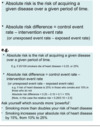Lecture 13- Evidence based medicine Flashcards
(20 cards)
measures of risk
Risk ratio
Odds ratio
risk ratio
or relative risk
ratio of incidence rate in group A vs incidence rate in group B
RR= Ia/Ib
odds ratio
used most often in case/control studies
- ratio of odds of ‘outcomes’ in eposed group vs odds of outcome in unexposed group
OR= odds of outcomeexposed/ odds of outcomeunexposed
risk ratio example
e.g. 25% chance of death
25/100
10/100
0.25/0.1
Risk ratio: 2.6

odds ratio example
Odds ratio e.g. 1 in 3 chance of dying
25: 74= 1:3
10: 90 = 1:9
Odds ratio =3

Absolute risk and absolute risk difference

P-value
- P-value is an expression of “statistical significance”
- It is the probability that the effect observed could have occurred by chance
- Thus, a small p-value implies a small ‘chance’ of that effect not being a ‘real effect’ of a given drug etc.
- Traditionally, p-values <0.05 are considered ‘statistically significant’, i.e. we are ‘happy’ to discount a 5% chance effect
- (or to put it another way, we are happy to consider that something that appears 95% likely to be a ‘true’ effect, is ‘sufficient’)
Issues with p-values
Issues with p-values
Doesn’t rule out chance
Give no indication of the size of the effect
P- values give no idea as to the range of uncertainty around the effect you have estimated
Confidence intervals
- From a study you generate an outcome (or result), for instance that your old treatment (drug A) reduces mortality by 50% (i.e. RR of 0.5) compared to your new treatment (drug B)
- Whilst your ‘best estimate’ is a RR of 0.5, there is ‘uncertainty’ around that estimate
- A 95% confidence interval ‘captures that uncertainty’. For your study you find the confidence interval is 0.2 to 0.8
- i.e. there is a 95% probability that the true relative risk of mortality for drug A vs drug B may be as much as 0.2, or as little as 0.8
- This finding would be statistically significant as the confidence interval for the relative risk does not include 1
for a result to be statistically signififcant the confidence intervals must not
cross 1


yes- doesnt cross 1

no-crosses 1

Yes (doesn’t cross 1)
Statistically significant reduction
what would be the absolute difference

1- 0.9= 0.1 kg
no difference would equal 0kg

A and D (doesn’t cross 0)
types of quantitative study design
observational and experimental
types of observational study design
- cross-sectional
- case studies./series
- case-control studies
- cohort studies
types of experimental study design
RCT
hierachy of evidence



